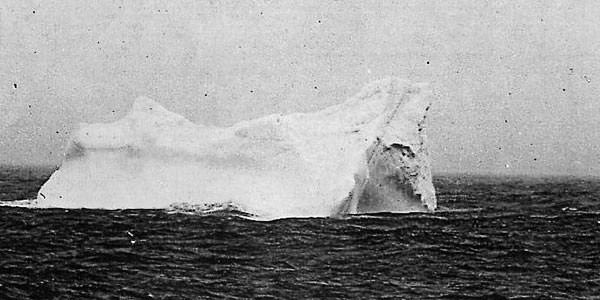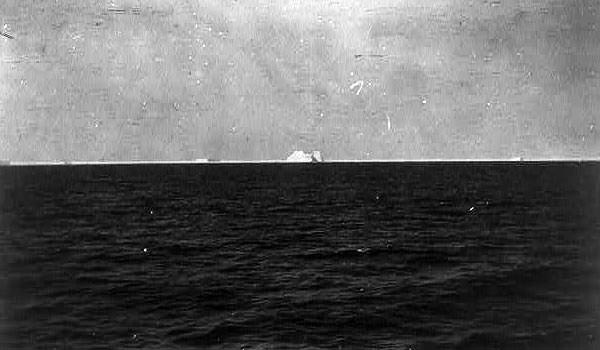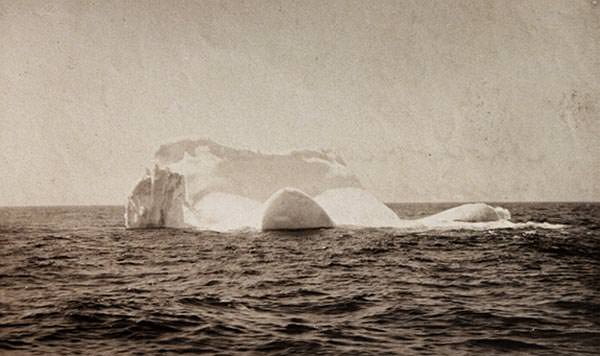Jump to the story of the iceberg that sank Titanic
Key Facts About The Iceberg
19 – the number of icebergs that third class survivor Charles Dahl later claimed he had seen from lifeboat number 15, during the hours following the sinking. In an interview with the Chicago American newspaper Dahl criticised the speed at which Titanic had been travelling through the icefield, describing how Carpathia had needed to zigzag through bergs whilst collecting survivors.
11:39 pm – the time at which the iceberg Titanic struck was first spotted, too late to avoid a collision (read more on the timeline).
30 seconds – the amount of time from the first sighting of the iceberg to the impact.
50 – 100 feet – the estimated height of the iceberg above water, as recounted by Titanic survivors.
200 – 400 feet – the estimated length of the iceberg.
5 – the number of days after the sinking when Rehorek took his photograph of the iceberg.
85% – the amount of all icebergs in the North Atlantic that originate from the west coast of Greenland.
40,000 – the approximate number of icebergs born each year along the coast of Greenland
Did You Know?
According to experts the Ilulissat ice shelf on the west coast of Greenland is now believed to be the most likely place from which the Titanic iceberg originated. At it’s mouth, the seaward ice wall of Ilulissat is around 6 kilometres wide and rises 80 metres above sea level.
1909 – the year in which the Titanic iceberg is believed to have been ‘born’.
1 – 2 – the likely number of icebergs that the Ilulissat ice-shelf would have produced in 1909.
1 – 4% – the proportion of those icebergs that survive to reach shipping waters. They initially float north along Greenland’s west coast before beginning their southward journey past the coastlines of Baffin Island, Labrador and Newfoundland, before passing through the gulf stream into the Atlantic past. Most do not make it this far, either getting caught en route or finally melting in the warm waters of the gulf stream.
1 mile – the likely original length of the Titanic iceberg. The year it would have taken to move along the 40 mile long fjord would have left the iceberg at around a half of its original size.
1,000,000,000 tons – the amount of sea water displaced by the iceberg at its original size (one billion tons!).
300 – the approximate number of icebergs reaching the shipping lanes of the North Atlantic in April 1912, the largest number for around 50 years. The appearance of icebergs this far south can be highly erratic; for example in 2006 the International Ice Patrol (the monitoring team set up after the Titanic disaster) recorded no icebergs crossing south of latitude 48°N; in 2007 they recorded 324.
1/10th – the amount of an iceberg’s total mass that is typically visible above water.
15,000 years – the approximate age of the first snowflakes that made up the glacier that produced the Titanic iceberg.
2 years – the approximate time that the Titanic iceberg will have taken since its creation to reach the point of collision.
8 miles – the approximate distance the iceberg would have been traveling per day.
14 – the approximate number of days after the collision that the Titanic iceberg would probably have disappeared, melting in the gulf stream’s warmer water.
The Story of the ‘Berg That Sank Titanic

Above: An iceberg photographed by Stephen Rehorek from aboard the MS Bremen, 20 April 1912, and believed to be the iceberg that sank the Titanic.
On the ill-fated night of April 14, 1912, Charles Dahl, a third-class passenger on the Titanic, survived the sinking by taking refuge on lifeboat number 15. He would later claim that, from this lucky vantage point, he observed nineteen icebergs in the hours that followed.
In an interview with the Chicago American newspaper, he also voiced criticism, accusing the Titanic of recklessly speeding through the perilous icefield. The rescue ship Carpathia, he went on to say, was forced to manoeuvre a zigzag route through these icy monoliths whilst collecting survivors.
As the clock struck 11:39 pm, the looming iceberg that would seal the Titanic’s fate was spotted. However, it was too late to avoid a collision; just thirty nerve-wracking seconds passed between the initial sighting and the catastrophic impact.
The iceberg was huge, towering between 50 to 100 feet above the water’s surface, and with an estimated length of 200 to 400 feet, according to witness accounts from Titanic survivors. Five days after the sinking, the first photograph of this notorious iceberg emerged, captured by a seaman named Rehorek, sailing aboard the MS Bremen.
But where did this colossal iceberg originate?
Remarkably, 85% of all North Atlantic icebergs are birthed along the west coast of Greenland, with an approximate 40,000 new icebergs created each year. Among these, the Ilulissat ice shelf is now believed to be the most likely birthplace of the iceberg that sank the Titanic.
With its seaward ice wall measuring around six kilometres wide and rising 80 metres above sea level, the Ilulissat ice shelf is a formidable sight. In 1909, this shelf likely produced between one to two icebergs, one of which was the Titanic iceberg. Only a small proportion of these icebergs, between 1% to 4%, endure the perilous journey to reach shipping waters.
Their path initially takes them north along Greenland’s west coast before embarking on a southward course past Baffin Island, Labrador, and Newfoundland. Finally, they venture through the Gulf Stream into the Atlantic. Most never complete this journey, however, becoming trapped or melting in the warm waters of the Gulf Stream.

Above: A view of the iceberg believed to be the one the Titanic hit, taken from aboard the Carpathia.
It’s believed that the Titanic iceberg was originally one mile in length, and this colossal iceberg would have displaced as much as a staggering one billion tons of seawater when at its full size. However, a year-long journey along the 40-mile-long fjord would have reduced it to half its original size. Still an imposing sight, and yet only a tenth of an iceberg’s total mass is typically visible above water.
By the time of the Titanic’s journey in April 1912, around 300 icebergs had made it to the North Atlantic shipping lanes, marking the largest number in approximately 50 years. This was a fact not lost on Captain Edward John Smith, the Commander of the Titanic, who once spoke of the dangers posed by icebergs: “We do not care anything for the heaviest storms in these big ships. It is fog that we fear,” he remarked.
We do not care anything for the heaviest storms in these big ships. It is fog that we fear. The big icebergs that drift into warmer water melt much more rapidly under water than on the surface, and sometimes a sharp, low reef extending two or three hundred feet beneath the sea is formed. If a vessel should run on one of these reefs half her bottom might be torn away. – Captain Arthur H Rostron, Commander of the Carpathia
Smith described how icebergs melt more rapidly underwater than on the surface, often forming dangerous reefs extending hundreds of feet beneath the sea. Should a vessel strike one of these hidden dangers, it could lose half its bottom, he warned.
The journey of the Titanic iceberg from its creation to the collision is estimated to have taken around two years. Incredibly, the first snowflakes that contributed to its formation were approximately 15,000 years old. Once formed and cast adrift, the iceberg would have travelled approximately eight miles per day.
Icebergs loomed up and fell astern and we never slackened. It was an anxious time with the Titanic’s fateful experience very close in our minds. There were 700 souls on Carpathia and those lives as well as the survivors of the Titanic herself depended on the sudden turn of the wheel. – Captain Arthur H Rostron, Commander of the Carpathia
Then, approximately two weeks after its fateful collision with the Titanic, the iceberg would have likely disappeared, simply melting in the warmer waters of the Gulf Stream.
How Are Icebergs Formed?
Icebergs are produced from the accumulation of snow on land, primarily in frigid regions such as Antarctica and Greenland. Gradually, the snow’s weight results in its compression and the formation of compacted ice. As additional snowfall occurs and is compressed, the ice sheet expands in thickness and mass.
Eventually, the ice’s heft causes it to extend from the core of the ice sheet and into the ocean. Large portions of ice sever and form icebergs. These bergs can be vast, occasionally measuring up to the size of a small island, and can move with sea currents.
Icebergs can also emerge when glaciers or ice shelves detach and drift out into the ocean. At this point, significant blocks of ice are freed into the water and can materialize as icebergs.
Icebergs are not equivalent to sea ice, however, which forms when seawater solidifies. Sea ice is typically thinner than icebergs and does not originate from land.
The story of the Titanic iceberg offers us a chilling reminder of the unforgiving forces of nature. Forces that can pose a danger to even the largest and most robust – even “unsinkable” – of human constructions.

Above: A possible photograph of the iceberg that hit Titanic, photographed from the liner Prinze Adelbertby a few miles south of the disaster scene.
More To Explore
If you’ve enjoyed reading about the Titanic iceberg why not discover facts about the ship, about the sinking of the Titanic and interesting details about the wreck underwater.
